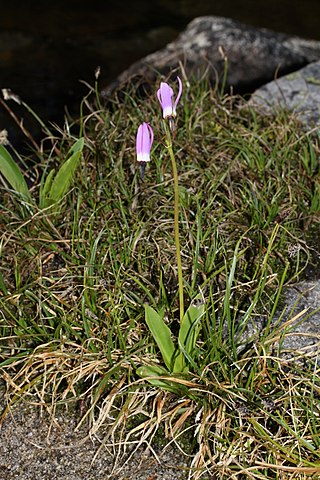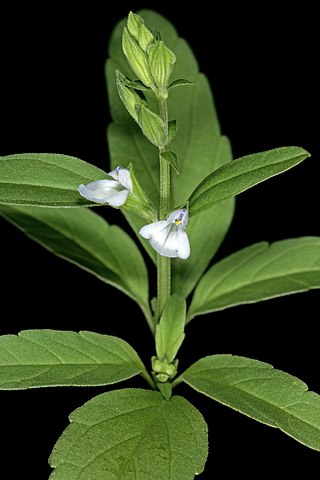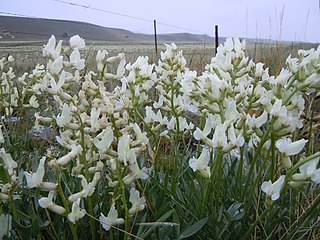Locoweed is a common name in North America for any plant that produces swainsonine, an alkaloid harmful to livestock. Worldwide, swainsonine is produced by a small number of species, most of them in three genera of the flowering plant family Fabaceae: Oxytropis and Astragalus in North America, and Swainsona in Australia. The term locoweed usually refers only to the North American species of Oxytropis and Astragalus, but this article includes the other species as well. Some references may incorrectly list Datura as locoweed.

Astragalus is a large genus of over 3,000 species of herbs and small shrubs, belonging to the legume family Fabaceae and the subfamily Faboideae. It is the largest genus of plants in terms of described species. The genus is native to temperate regions of the Northern Hemisphere. Common names include milkvetch, locoweed and goat's-thorn. Some pale-flowered vetches are similar in appearance, but they are more vine-like than Astragalus.

Rhododendron groenlandicum is a flowering shrub with white flowers and evergreen leaves that is used to make a herbal tea.

Hemerocallis fulva, the orange day-lily, tawny daylily, corn lily, tiger daylily, fulvous daylily, ditch lily or Fourth of July lily, is a species of daylily native to Asia. It is very widely grown as an ornamental plant in temperate climates for its showy flowers and ease of cultivation. It is not a true lily in the genus Lilium, but gets its common name from the superficial similarity of its flowers to Lilium and from the fact that each flower lasts only one day.

Oxytropis campestris, the field locoweed, is a plant native to Northern Europe, the mountains of Central & Southern Europe, the Northwestern United States and all of Canada, sometimes grown as an ornamental plant.

Oxytropis is a genus of plants in the legume family. It includes over 600 species native to subarctic to temperate regions of North America and Eurasia. It is one of three genera of plants known as locoweeds, and are notorious for being toxic to grazing animals. The other locoweed genus is the closely related Astragalus. Most oxtropis species are native to Eurasia and North America, but several species are native to the Arctic. These are hairy perennial plants which produce raceme inflorescences of pink, purple, white, or yellow flowers which are generally pea-like but have distinctive sharply beaked keels. The stems are leafless, the leaves being all basal. The plant produces legume pods containing the seeds.

Pedicularis groenlandica is a showy flowering plant in the family Orobanchaceae commonly known as elephant's head, little pink elephant, elephantella, or similar common names inspired by the resemblance of the flower to the head of an elephant. It is also less commonly known as butterfly tongue for the long beak on the flower. Like many other plants in genus Pedicularis, it is a parasitic plant and depends on host plants to survive.

Primula jeffreyi, synonym Dodecatheon jeffreyi, is a North American species of flowering plant in the primrose family known by the common names Sierra shooting star, Jeffrey's shooting star, and tall mountain shooting star.

Corallorhiza mertensiana, or Pacific coralroot, is a coralroot orchid native to the shady conifer forests of northwestern North America. It also goes by the common names Western coralroot and Mertens' coralroot. Corallorhiza mertensiana was previously considered a subspecies of Corallorhiza maculata but was given species rank in 1997 by Freudenstein.

Salvia reflexa, the lanceleaf sage, Rocky Mountain sage, blue sage, lambsleaf sage, sage mint or mintweed, is an annual subshrub native to the United States and Mexico and introduced to Argentina, Australia, Canada, South Africa and New Zealand.

Prosartes trachycarpa, the roughfruit fairybells, rough-fruited fairybells or rough-fruited mandarin, is a North American species of plants in the lily family. The species is widespread, known from British Columbia to Ontario and south to Arizona and New Mexico. One isolated population was reported from Isle Royale in Lake Superior.

Sedum lanceolatum is a species of flowering plant in the family Crassulaceae known by the common names spearleaf stonecrop and lanceleaf stonecrop.

Oxytropis lambertii commonly known as purple locoweed, Colorado locoweed, Lambert's crazy weed, or Lambert’s Locoweed is a species of flowering plant in the legume family.

Oxytropis podocarpa is a species of flowering plant in the legume family known by the common names stalkpod locoweed, stalked-pod crazyweed, and Gray's point-vetch. It is native to North America, where it occurs in the northern latitudes, from Yukon and British Columbia across the low arctic to northern Quebec and Labrador. In the Rocky Mountains it occurs at the higher elevations as far south as Colorado.

Oxytropis sericea is a species of flowering plant in the legume family known by the common names white locoweed, white point-vetch, whitepoint crazyweed, and silky crazyweed. It is native to western North America from Yukon and British Columbia south through the Pacific Northwest, the Rocky Mountains, and the Great Plains.
Salix brachycarpa is a species of flowering plant in the willow family known by the common names barren-ground willow, small-fruit willow and shortfruit willow.

Tetraneuris acaulis is a North American species of flowering plants in the sunflower family. It is known by many common names in English including stemless four-nerve daisy, stemless hymenoxys, butte marigold, and stemless rubberweed.

Erigeron speciosus is a widespread North American species of flowering plants in the family Asteraceae known by the common names aspen fleabane, garden fleabane, and showy fleabane.

Mertensia lanceolata, known as prairie bluebells, lance-leaved bluebells, lance-leaved lungwort, and narrow-leaved languid ladies is a species of flowering plant native to the Rocky Mountains and areas of the northern Great Plains in western North America. A herbaceous perennial it has blue-green leaves alternately arranged on its smooth flowering stalk. Its flower buds are pink-purple and become blue as they open.


















